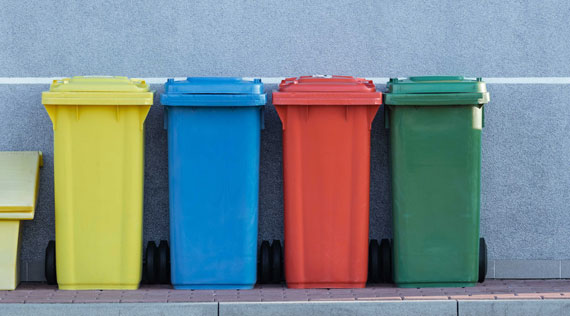RecyclingMonster - The decision is as clear as glass. The Housatonic Resources Recovery Authority (HRRA) will be requiring local homeowners and businesses in Newtown along with other communities in its jurisdiction to separate out qualified glass containers starting in June.
Jennifer Heaton-Jones, HRRA Executive Director told The Newtown Bee earlier this week that the regional, governmental, waste management and recycling authority serving 11 municipalities in western Connecticut is making the move to separating most types of consumer glass containers for both environmental and economic reasons.
“I’ve found you can tell the public what to recycle and when to recycle, but I don’t see as much buy in until they understand why,” Ms Heaton-Jones said. “They need to see the value and positive impact.”
The HRRA executive said it was an unpleasant surprise back in 2017 to learn a portion of the glass being disposed of in the agency’s service area was not being recycled.
“It was never going from bottle to bottle as a recycled item, it was going straight to landfill,” she said. “In addition tip fees were constantly climbing because of so much glass mixed in with other waste. If we got glass out, we could reduce cost”
Ms Heaton-Jones said that is because glass is the heaviest material in the mixed recycling stream, and municipalities end up paying for the trucking and dumping of that waste and recycling by the pound. This hits local taxpayers right in the wallet, and in just the past three years, recycling tipping fees for HRRA communities have increased from about $10 to $73 per ton.
“Glass represents anywhere between 20 and 27 percent of the total recycling stream on average locally,” Ms Heaton-Jones said.
She also highlighted Newtown as unique among all the HRRA municipalities, because it is the only community that provides town-wide municipal curbside recycling collections.
“So that expense is on the backs of taxpayers,” she said. “But when we start taking out the weight, it can provide taxpayers a significant cost savings. This is not just a carbon footprint thing, with glass being recycled into other products; it’s an economic issue as well.”
Willing To Cooperate
A public survey initiated by HRRA showed 90 percent of 695 consumers said they would be willing to separate glass from other recycling if asked. And if a waste hauler did not provide separated glass pickups, 75 percent of those surveyed said they would drive glass recycling to a local collection center.
The challenge, Ms Heaton-Jones said, is to help consumers understand exactly what kind of glass is able to be recycled. Today, glass beverage bottles, juice containers, condiment bottles, and glass food containers are accepted and recycled.
But mix in just a little bit of mirror glass, a household drinking glass, ceramic or clay pots, crystal, light bulbs, window glass, ovenware — and the entire load could be rejected as being contaminated — causing it all to be dumped into a landfill, even though it may contain a high percentage of recyclable content.
This is the kind of thing that has kept Ms Heaton-Jones and her colleagues at HRRA up nights.
“Our new approach, which goes into effect in June, is to send recyclable glass to Urban Mining Northeast,” she said. “Urban mining is going to use it to make composite cement blocks, which creates a much healthier environment for those people making cement. It also makes the finished product more LEED qualified.”
According to a report at concretedecor.net, glass aggregate is typically graded by size, and sizes can range from sand-like powder to fist-sized chunks.
Recycled glass aggregate in the concrete not only adds to the LEED points, using finely ground clear glass in place of sand can make for purer colors of the matrix. Finely ground glass also lends itself nicely to highly polished finishes, and putting a high polish on concrete loaded with finely ground, earth-toned glass aggregate can create marble or granite effects.
On March 2 the HRRA will be holding a meeting and inviting a vendor that may end up providing the agency a glass pulverizing machine.
“Perhaps instead of collecting the glass, sending it to a transfer station, then sending it to Urban Mining — paying the tip fees and transportation cost — by pulverizing it in one central municipality, all the glass from all 11 towns will go to the one location,” Ms Heaton-Jones said. “So HRRA would buy the pulverizing machine as a region, pulverize the glass, and use it for local municipal projects.”
That would not only cut the cost of tipping fees and transportation, but provide a ready source of natural resources such as the [concrete] blocks in building projects,” she added.
Plan To Separate
Ms Heaton-Jones said Newtown residents should either plan to begin separating out qualified glass for recycling pickup once the new program is in effect, or bringing all their glass recycling to the local transfer station.
“They cannot just put it in their trash because by state mandate it is recyclable material,” she said. This type of program is already working in Fairfax County, Va., and Ms Heaton-Jones said she will be talking with representatives there to help guide the local roll-out of this new recycling initiative.
Logistics could involve either dispatching split body container trucks weekly, with drivers tossing glass into one side and the rest of and recyclable materials into the other. Haulers with single body containers may have to use a week on, week off schedule, making two monthly collections exclusively for glass and the remaining two for all recyclables except glass.
Ms Heaton-Jones said there would be nothing wrong with beginning to separate out glass into its own container and putting it out alongside any remaining recycling.
The HRRA plans to give quarterly updates to CT DEEP to help them gain insight on the effectiveness and suitability of an alternative approach to glass collection.

